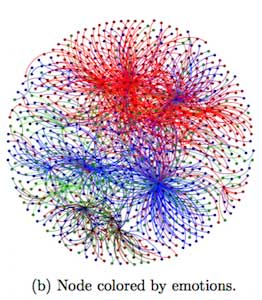The spread of anger in social networks and its implications for political violence
An ingenious study using the massive Weibo network revealed insights into the spread of certain emotions through social networks. Weibo is a social network platform not unlike Twitter. It is also hugely popular in China with millions of users making it an ideal platform for understanding how emotional states between socially-connected users correlate with each other.
But the highest correlation by far was among angry users. Rui and co say anger strongly influences the neighbourhood in which it appears, spreading on average by about 3 hops or degrees. “Anger has a surprisingly higher correlation than other emotions,” they say.
In the figure above, anger is depicted in red, and shows a greater pervasiveness than joy, sadness, and disgust. The study quantitatively looked at the correlation of emotion across the network and found that of all the emotions studied, anger showed the greatest diffusion.
Undoubtedly this mirrors the infectiousness of hate among like-minded people on other social network platforms and in the “real world.” The potential for each person to become a node in a network of anger and hate is what is frightening about the violent political spectacle that has come to characterize the U.S. presidential campaign of Donald J. Trump. Anyone who carefully listens to his rhetoric and its results cannot help but see the similarities to that of pre-WWII fascists. Furthermore, anyone who thinks that humans have fundamentally evolved in less than 100 years is mistaken. The latent potential for large numbers of people to do harm to under-represented scapegoats is still there.
This is a bad situation.
